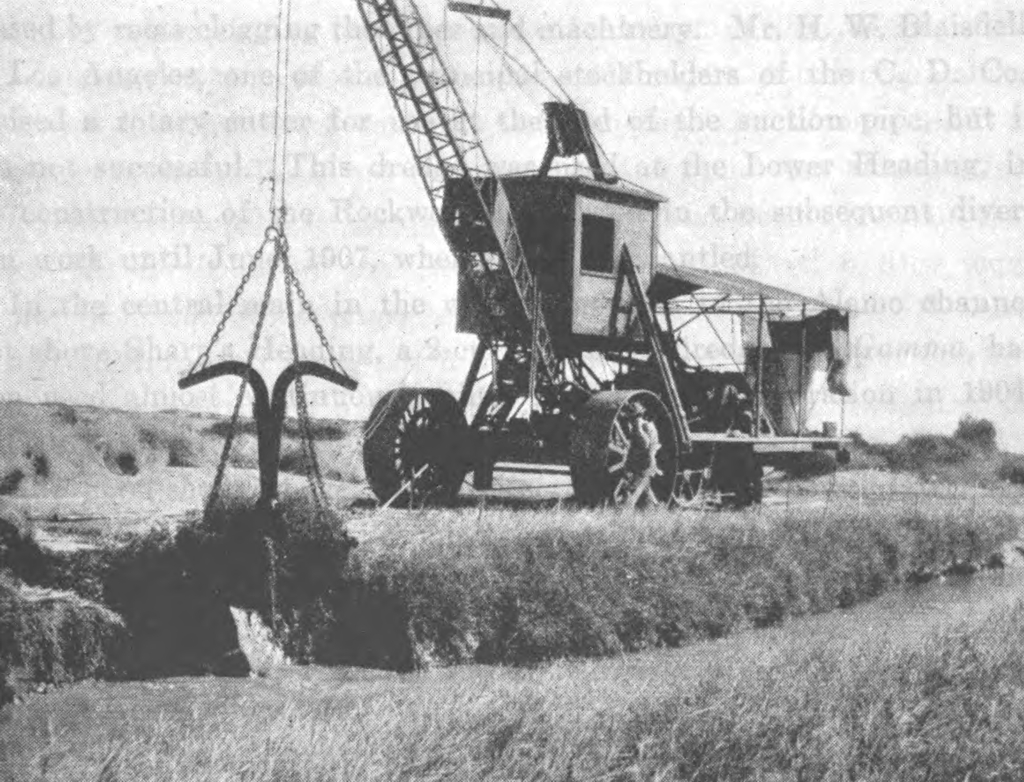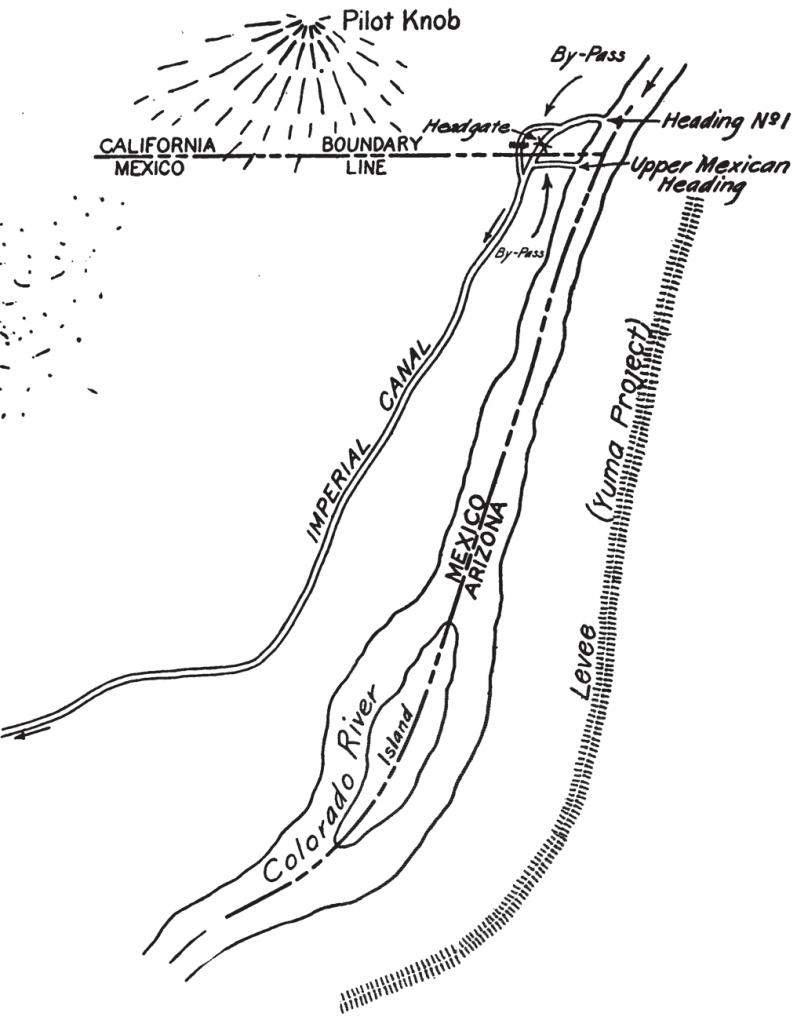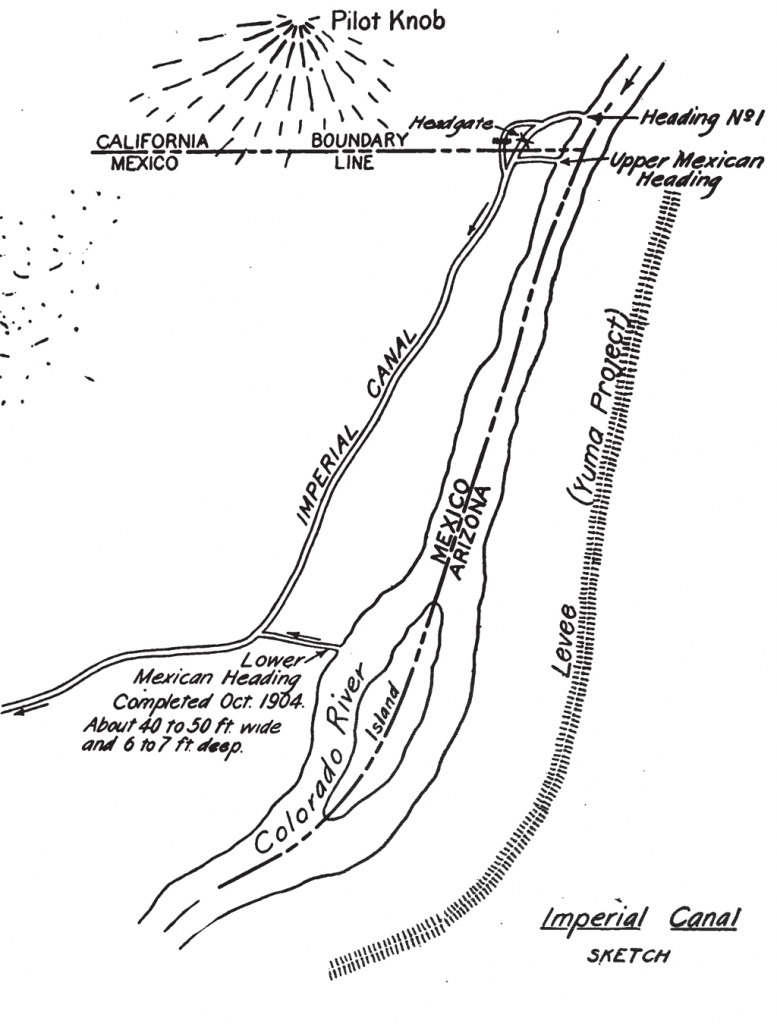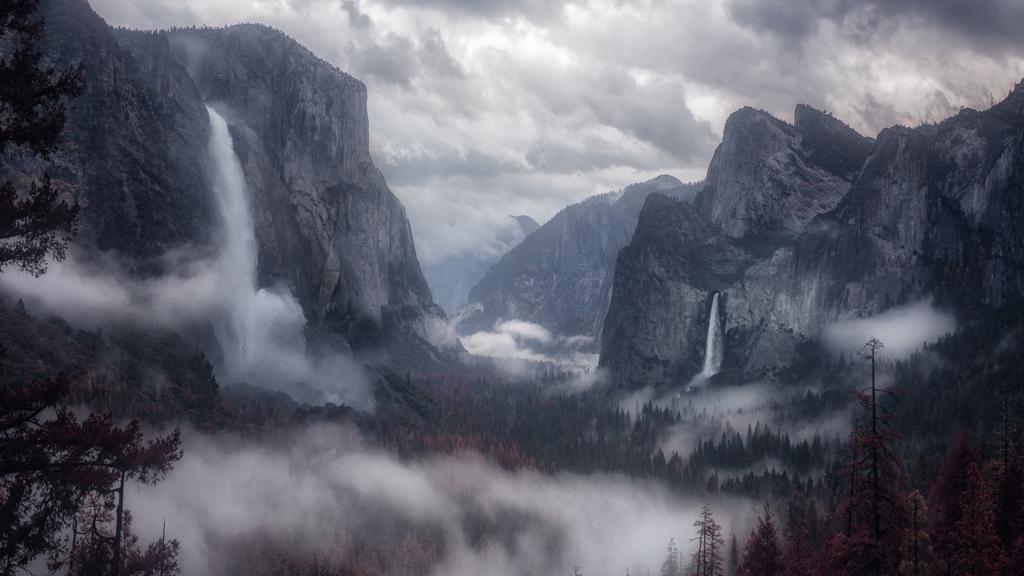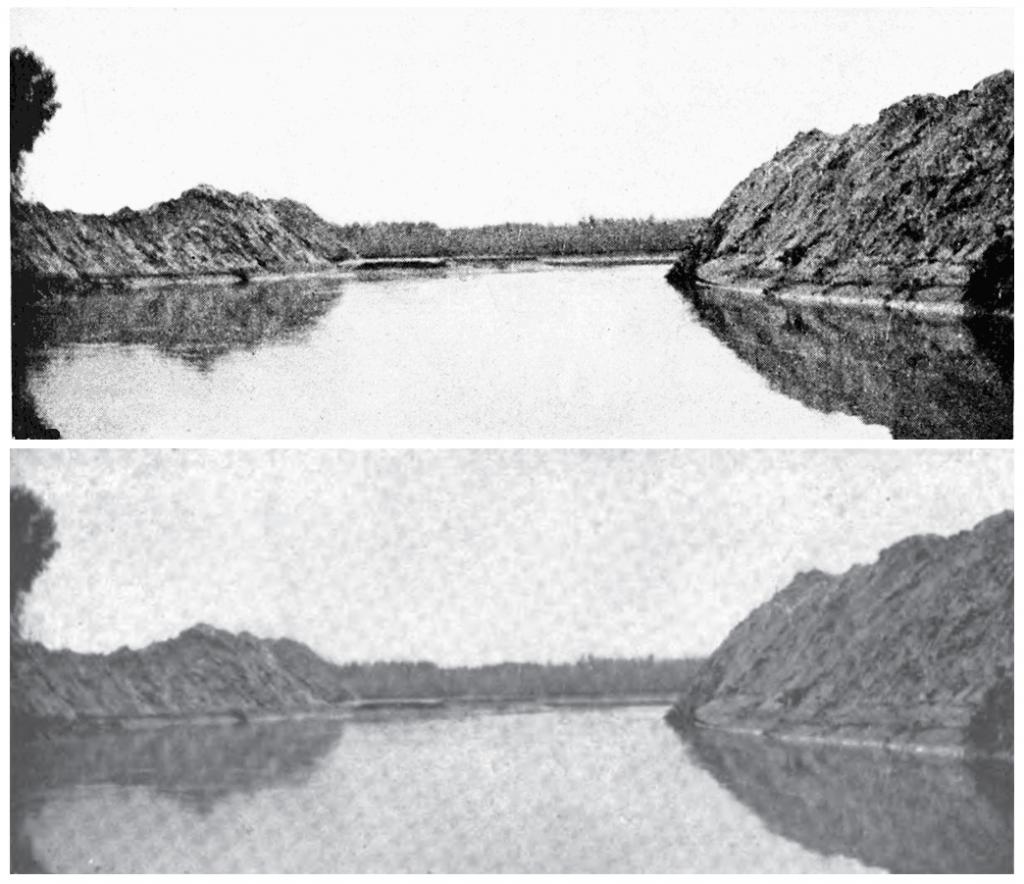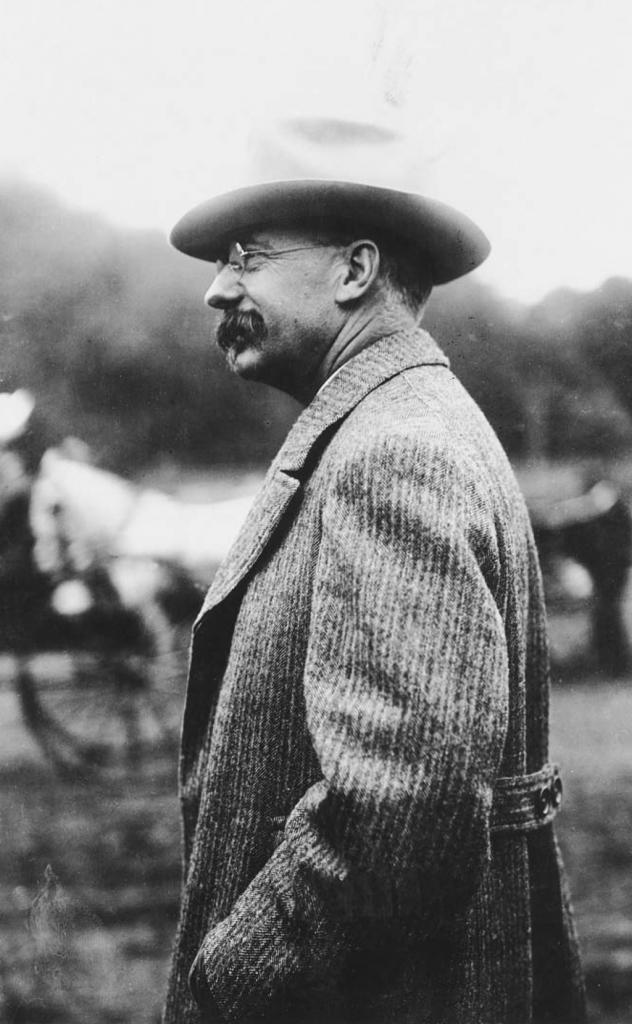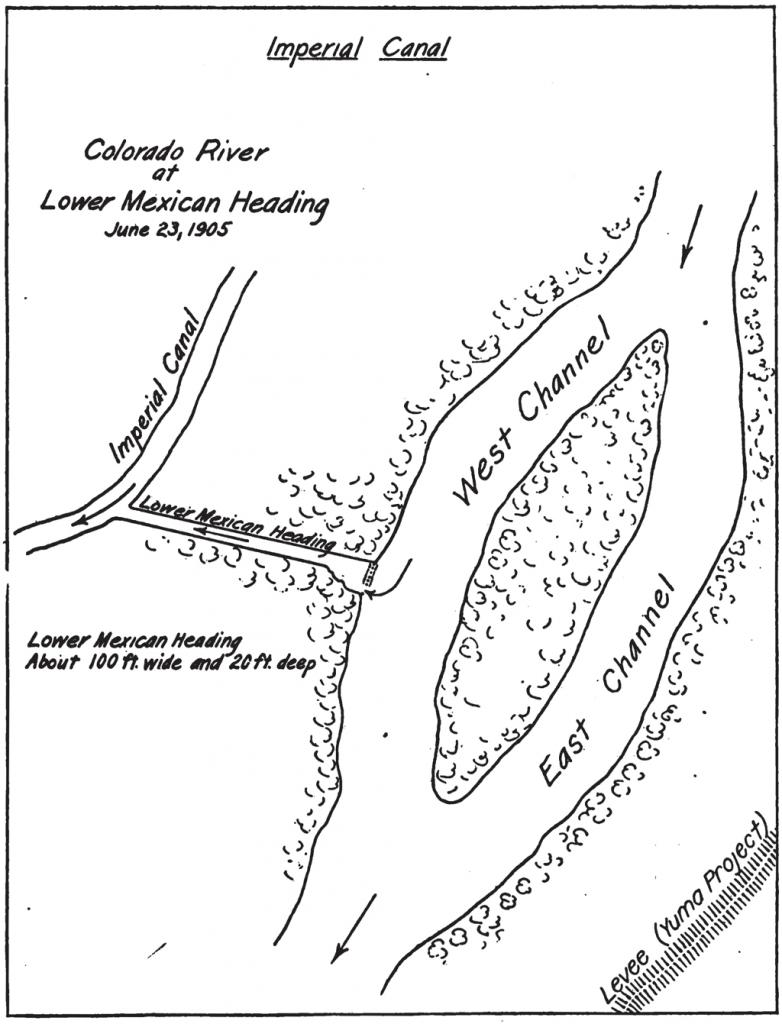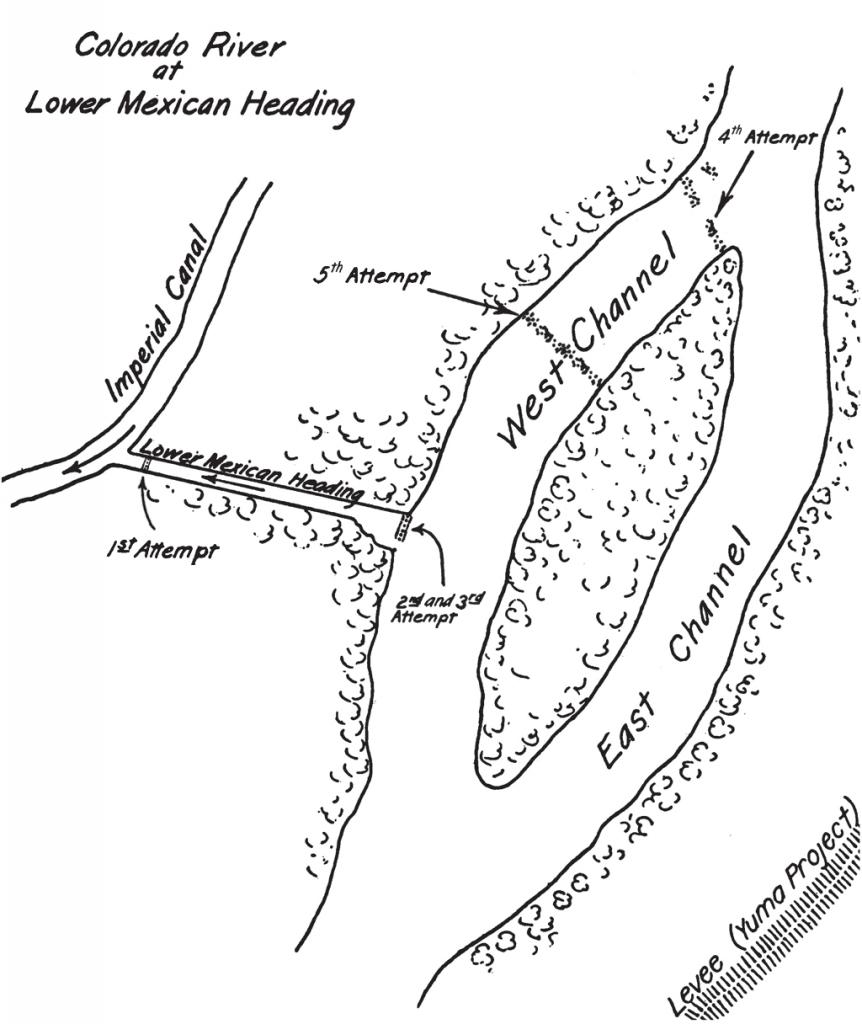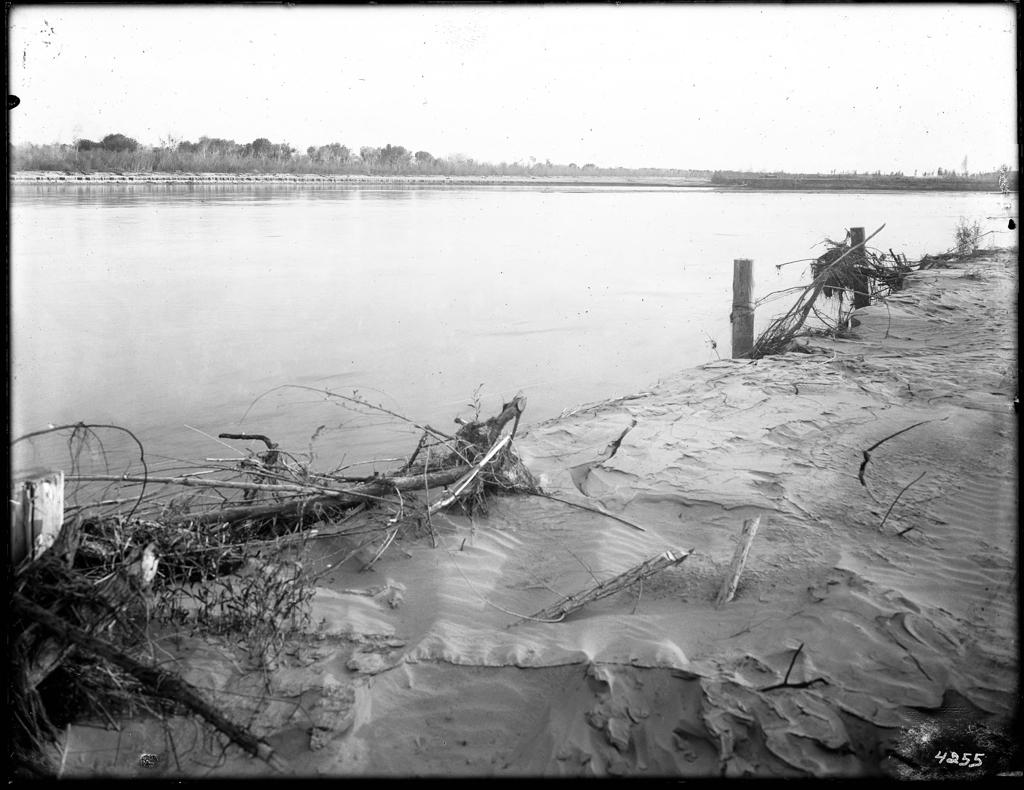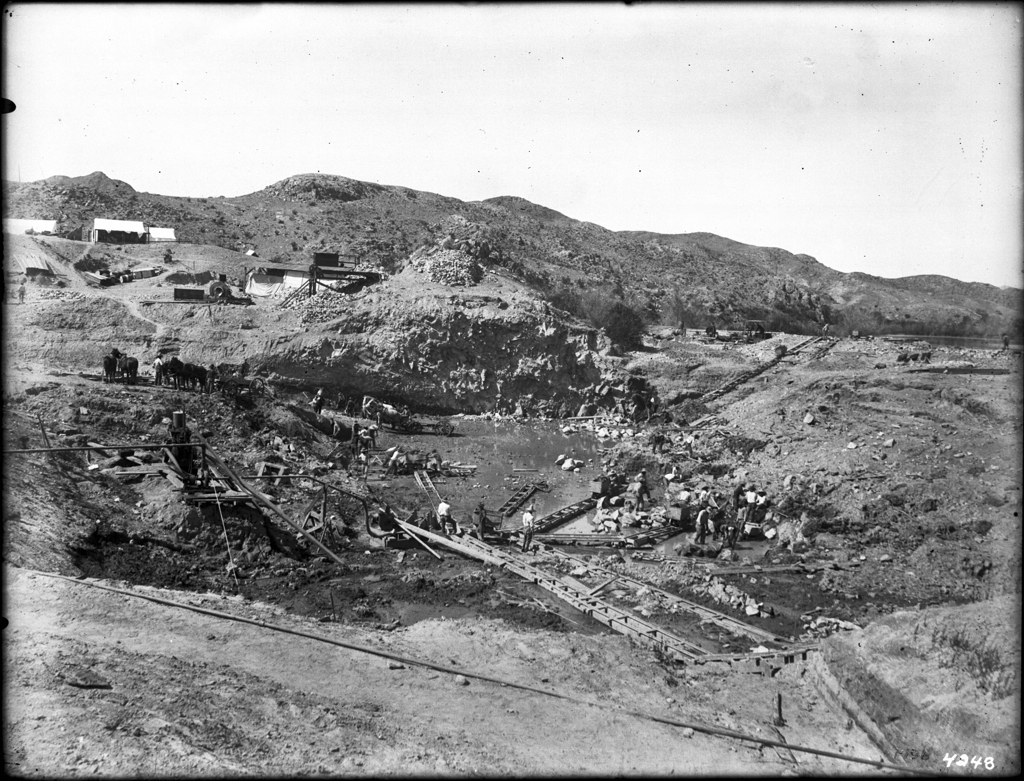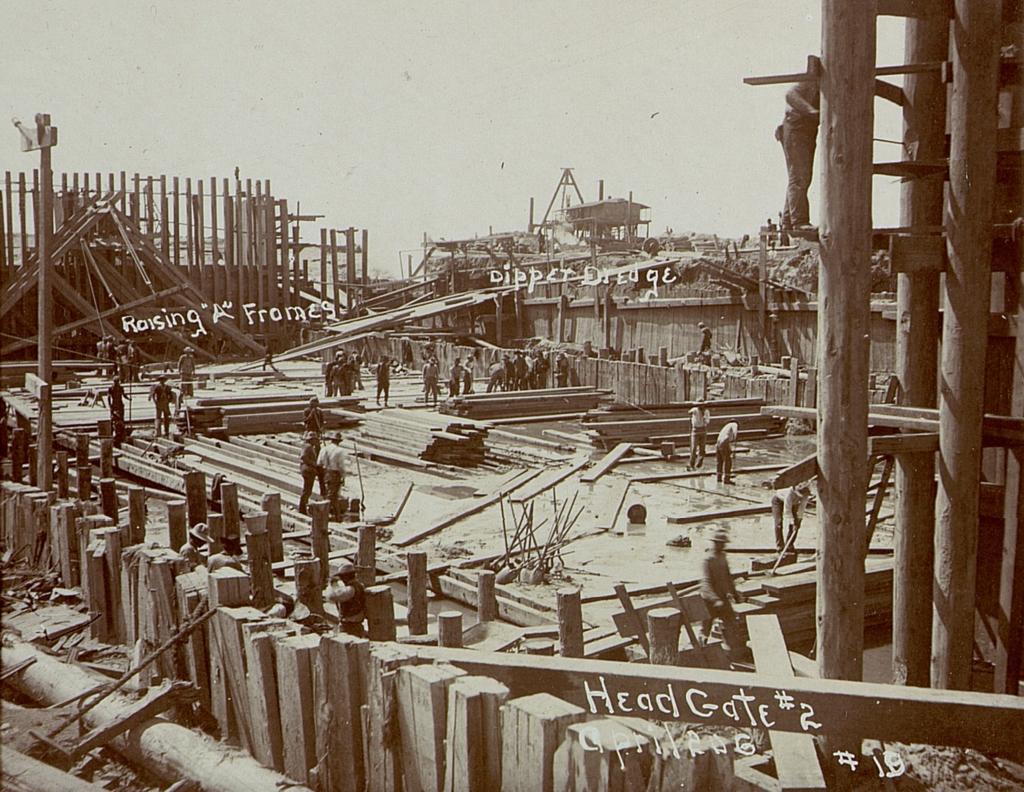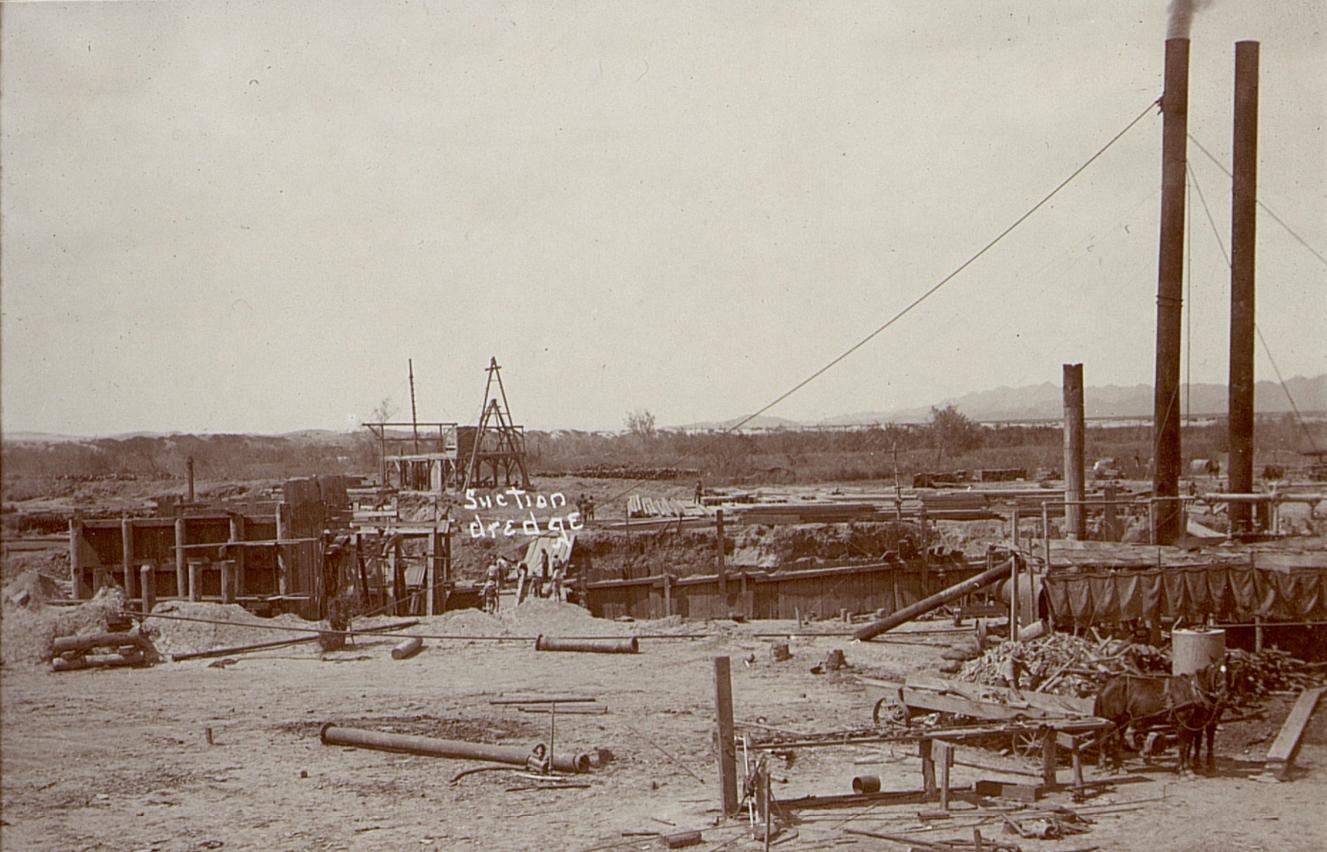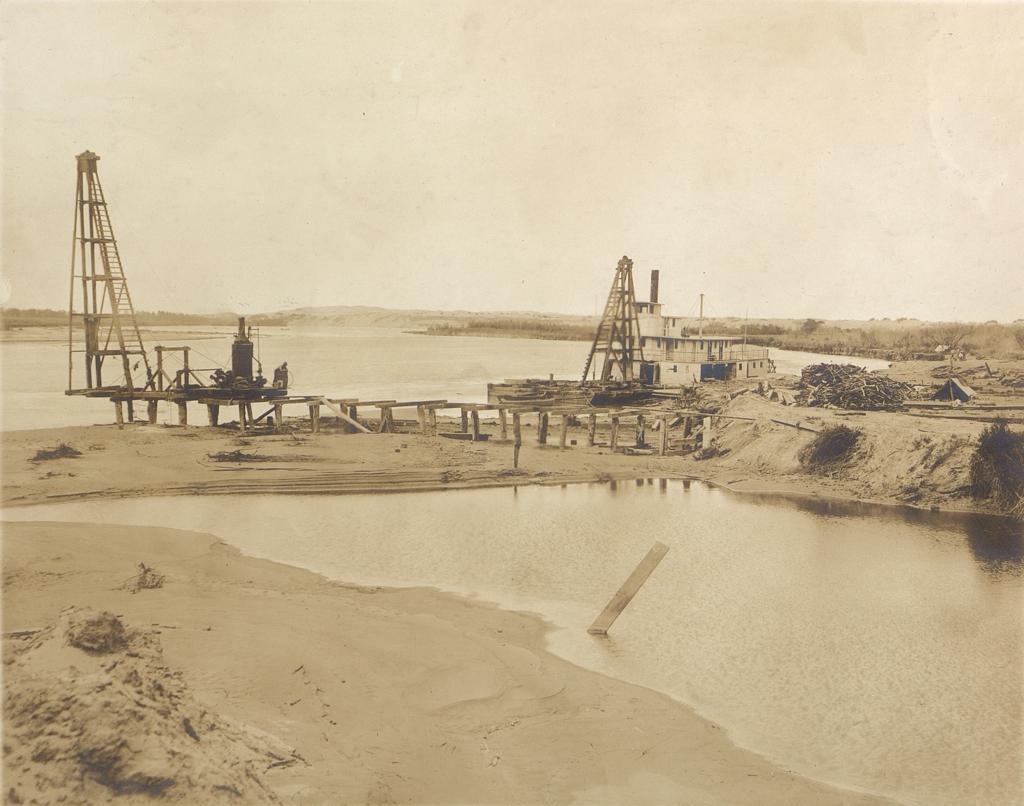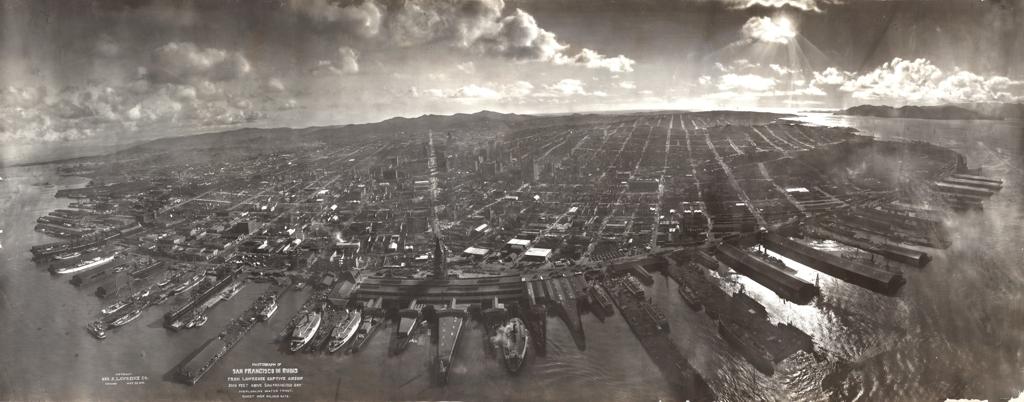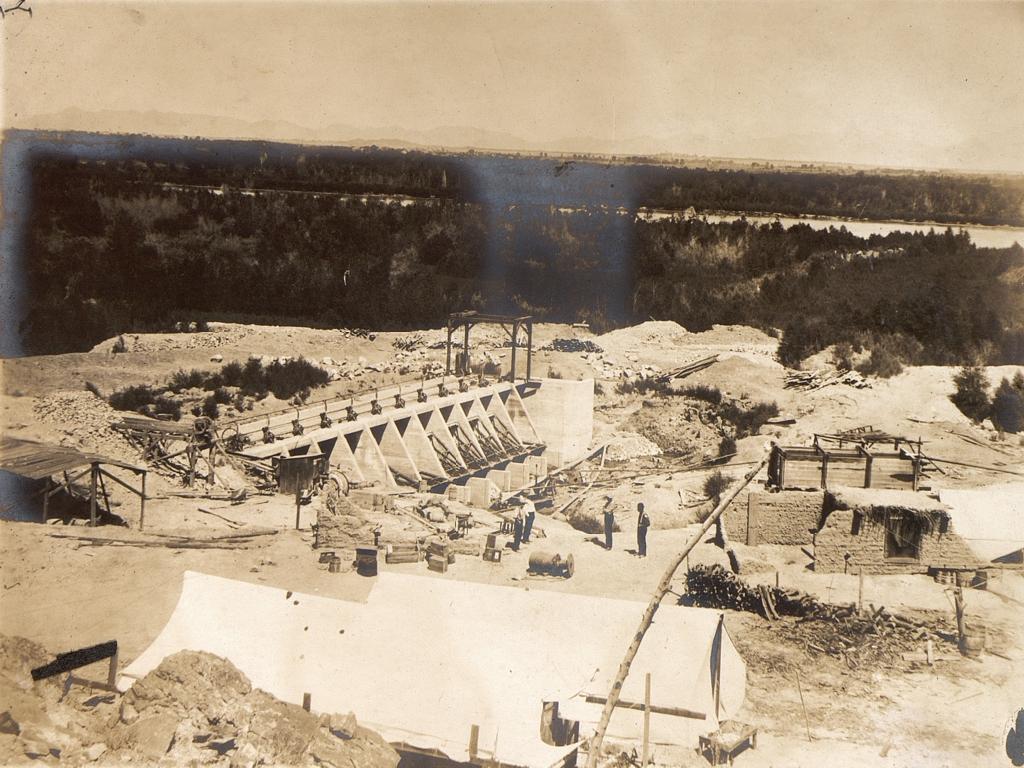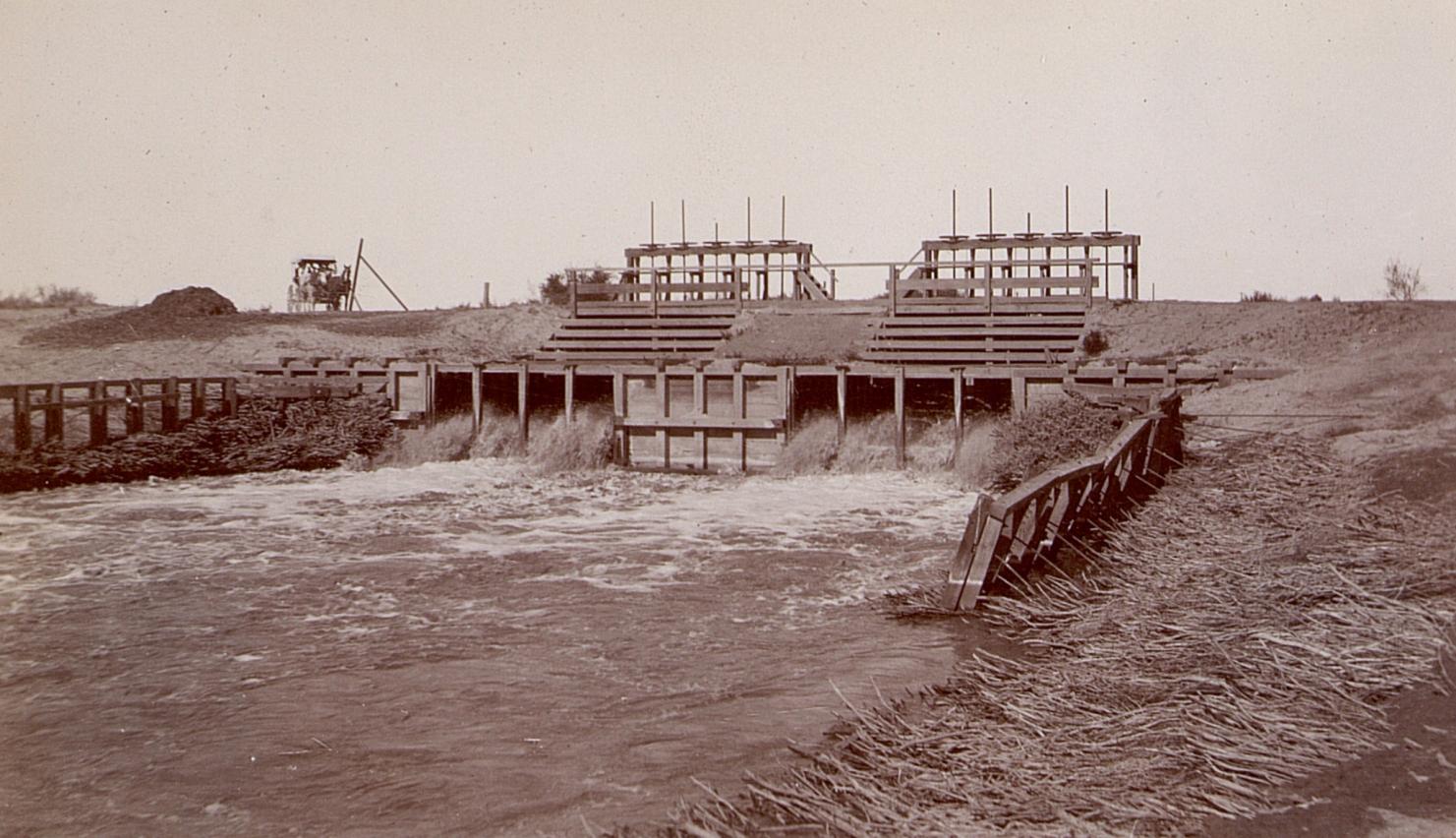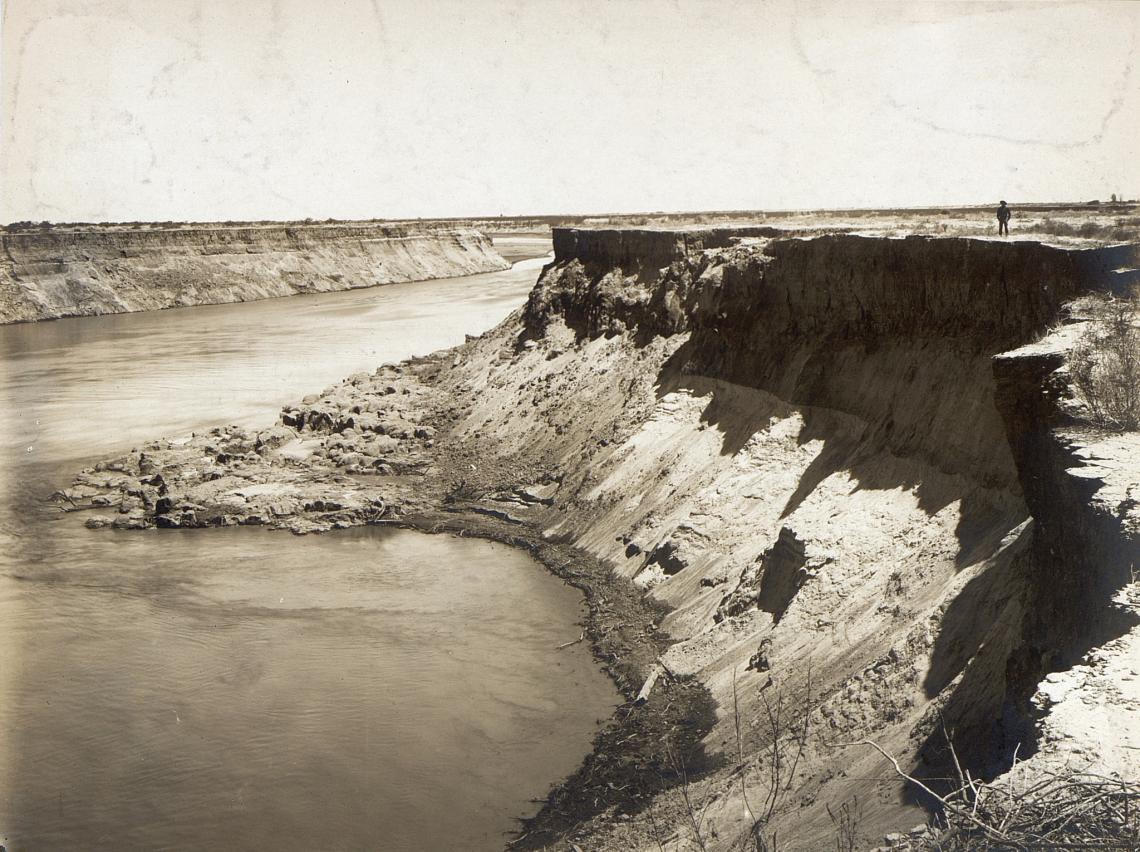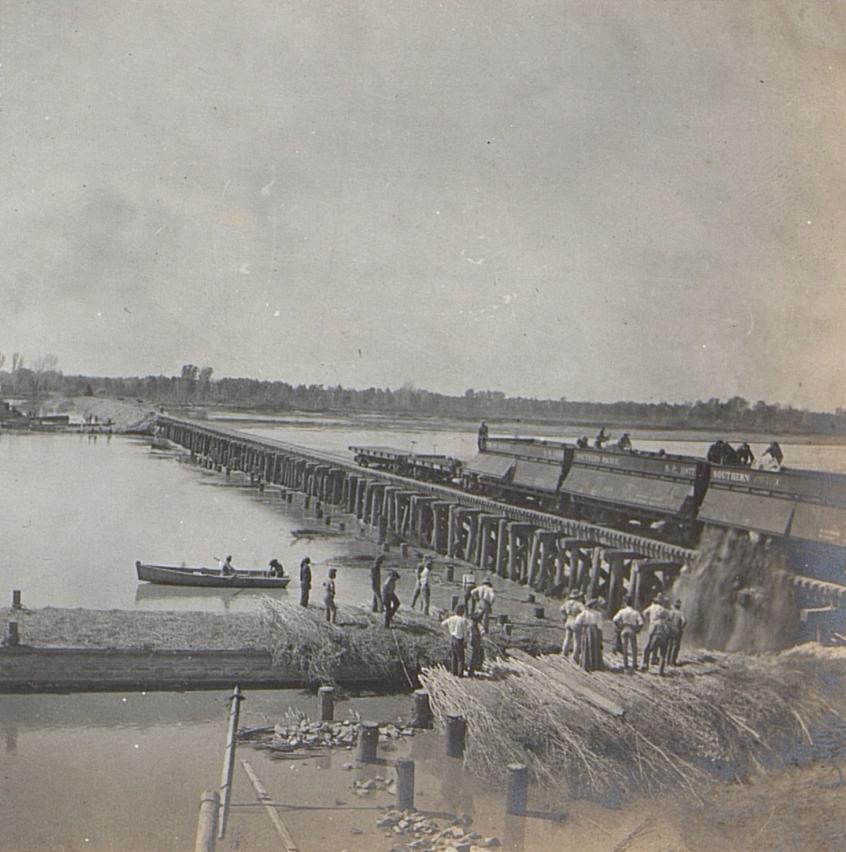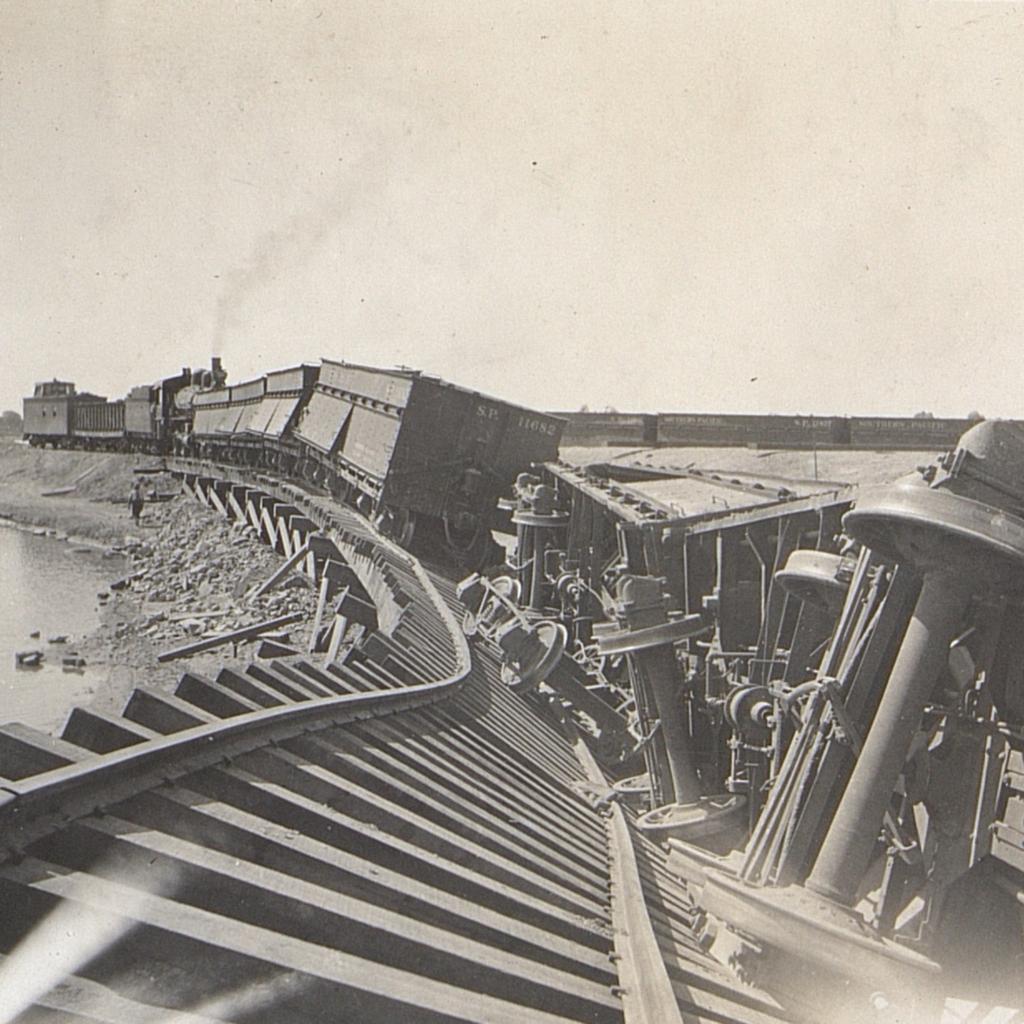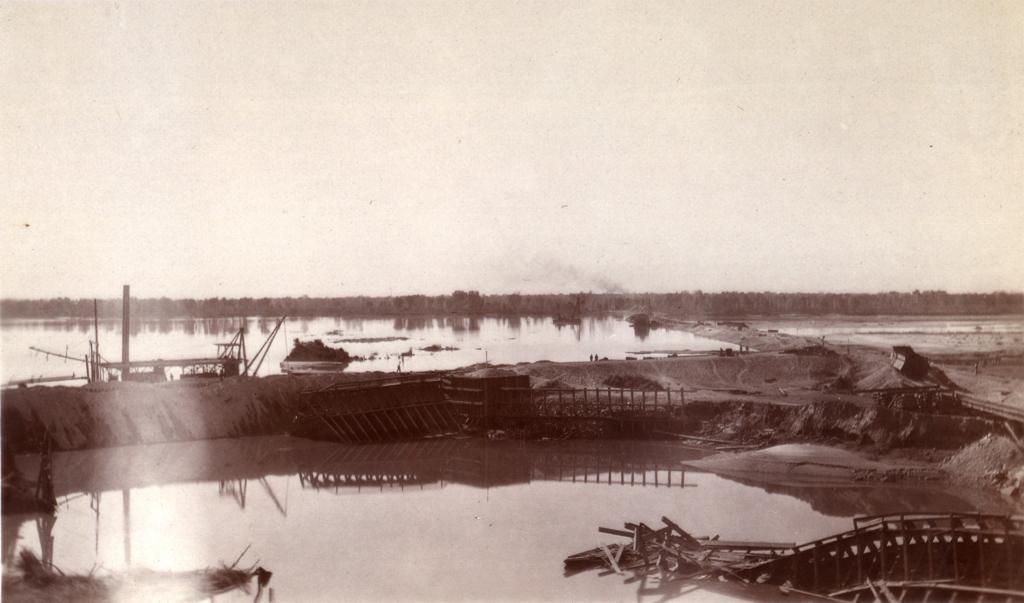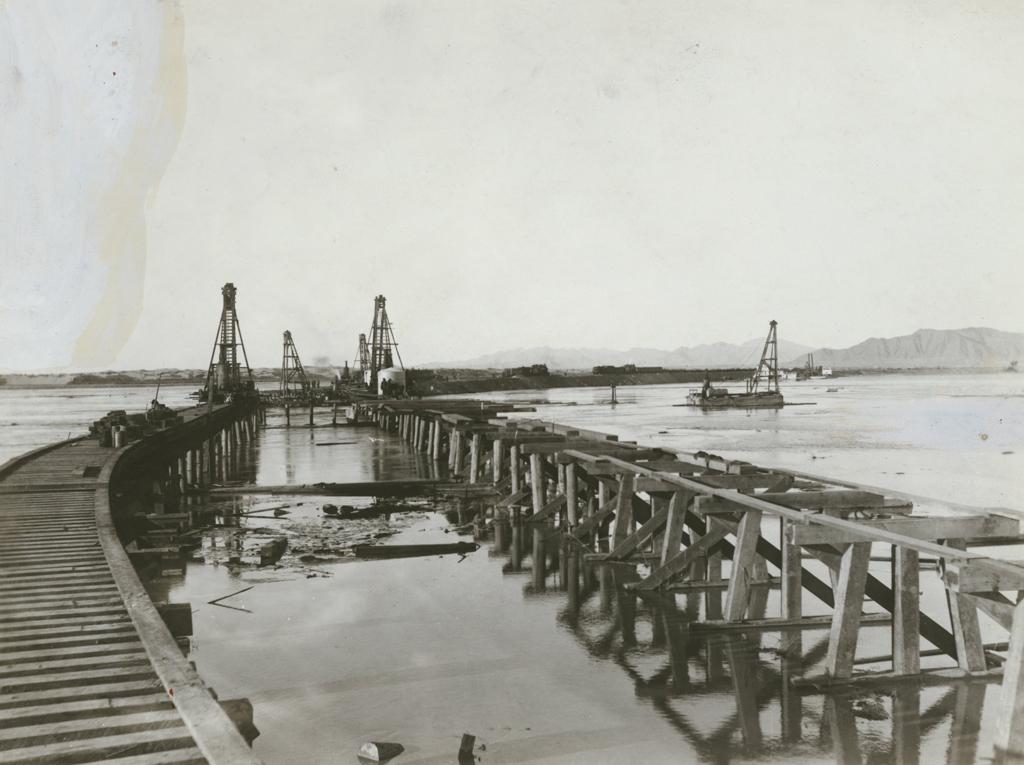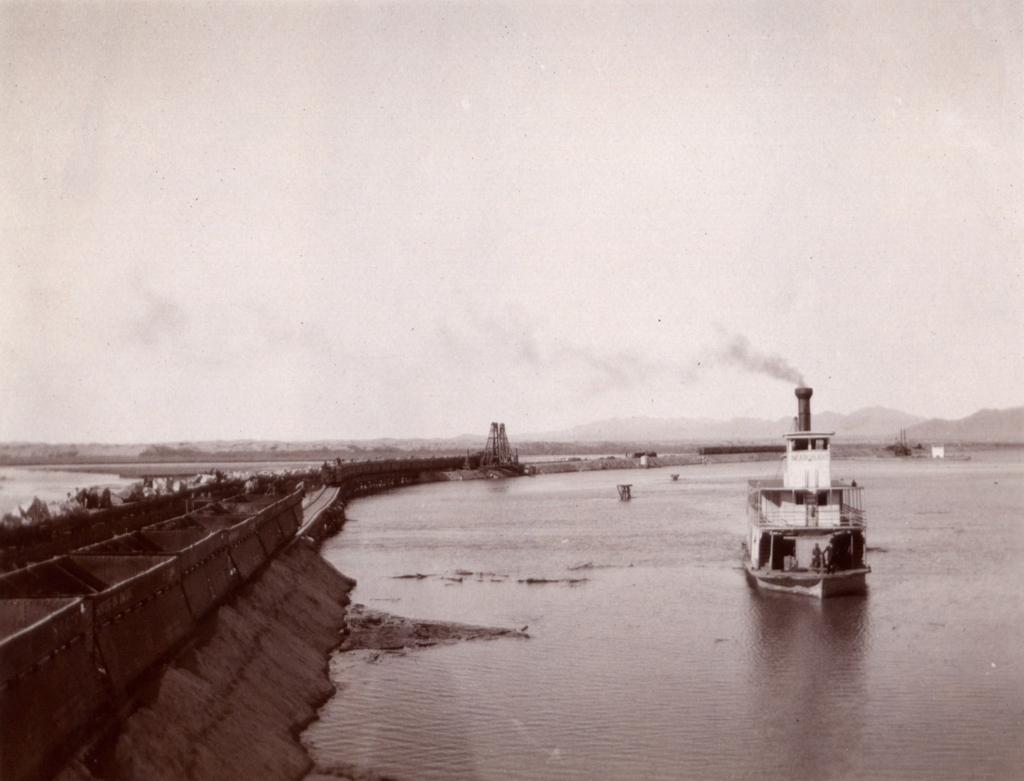1904
The Salton Sea was created by flood waters from the Colorado River that traveled through a largely uncontrolled canal system. Flooding of the river was a normal summer occurrence prior to the construction of the Boulder / Hoover Dam and other dams upstream of of the Imperial / Alamo Canal. During these floods, the water level of the river could rise as much as 20 ft., increasing the water flow by more than 20 times the average volume.
The difficulties and perils of of designing a canal system that could handle such wildly ranging extremes were not fully understood by the canals original designer, George Chaffey. It would prove to be problematic and dangerous in the future.
The Glen Canyon Dam During Construction 1963
Note; Although the Glen Canyon Dam is upstream of the Imperial / Alamo Canal, Boulder / Hoover Dam is the primary dam for flood control of the southern Colorado River.
High Resolution Image
Super High Resolution Image
Super High Resolution Image with Super Zoom
Jan 1904
The Colorado River carries a great deal of silt as it flows downstream. From the very beginning of its existence, this presented a problem for the Imperial – Alamo Canal. As the silt built up on the bed of the upper 4 mile section of the canal over the years, it caused the water flow to steadily decline.
The crops growing in the Imperial Valley were desperately thirsty for more water, but the canal system simply couldn’t deliver enough. The first effort to correct the problems was an attempt to remove the silt and increase the water supply by scouring the channel, but it failed. Dredging was considered, but neither time or money was available to complete such a large task.
If the California Development Company couldn’t find a solution for delivering adequate water, crops would die and the Imperial Valley would cease to exist.
Clam-Shell Dredge
Sources & Additional InformationSept 1904
In addition to silt build up in the upper 4 mile section of the Imperial / Alamo Canal, deficiencies were discovered with the Chaffey Headgate that prevented sufficient water flow to the expanding cropland in the Imperial Valley when the Colorado River level was low . Several additional channels were dug at the north end of the canal to bypass the headgate that allowed more water into the valley, but because they were built without headgates the water flow could not be controlled.
Decisions like this would prove to be a costly mistake in the future.
Map Depicting Bypass Channels around the Chaffey Headgate
Notes; In this illustration, the Chaffey Headgate is indicated by an X. The bypass channel in US territory was dug around the headgate. A line in this channel seems to indicate the existence another headgate, but nothing was ever constructed at that location. Heading No. 1 was also referred to as Intake # 1 and the Upper Mexican Heading was also referred to as Intake # 2.
Sources & Additional InformationOct 1904
The largest of the new channels dug was the Lower Mexican Heading , located about 4 miles south of the US / Mexican border. It was dug to bypass the upper 4 mile section of the Imperial / Alamo Canal north of the heading that had been rendered unusable from silt deposits. After completion, a sufficient water supply for the the Imperial Valley was restored, but as with the other bypass channels, it too lacked a headgate to control the flow of water.
There were plans to install a headgate, but building one at this location required the consent of the Mexican government and unfortunately it was not approved until the following year.
Map Depicting Location of The Lower Mexican Heading
Note; The Lower Mexican Heading was also referred to as Intake # 3.
Sources & Additional InformationJan 1905
The water that gave birth to the Salton Sea can be traced back to surface runoff from an unusual number of severe storms in the areas surrounding the upper Gila River, upper Colorado River, and their tributaries during the winter and early spring. Downstream, the unusual rainfall caused several massive floods that swept through the lower Colorado River region.
The volume of water that flowed through the lower Colorado River in the first half of 1905 was the largest amount ever documented since record keeping began.
Depiction of Heavy Runoff from Storms into a River Valley
High Resolution Image
Super High Resolution Image
Super High Resolution Image with Super Zoom
Feb 1905
Several unexpected winter floods on the lower Colorado River caused heavy silt build up in the Lower Mexican Heading and severely reduced the amount of water that could be delivered to the Imperial Valley for farms and crops. After the channel was dredged the canal system was once again able to provide a sufficient water supply for the valley.
Maintaining adequate water flow was the primary objective of the engineers, who had very little concern over potential flooding in valley. This would prove to be a very serious mistake.
Inside the Lower Mexican Heading , West of the Colorado River
Duplicate pictures from two different sources are presented here in order to provide alternate views from the limited quantity of low quality images available. They were taken from within the Lower Mexican Heading looking east. The steep banks on either side of the channel are the dirt and silt that was dug up to create the heading.
Mar 1905
Another unexpected flood, the third of the year, washed down the Colorado River and through the Lower Mexican Heading . But unlike the floods from the previous month, this one scoured the channel making it wider and deeper. This startled Mr. Rockwood to such a degree that he immediately made the decision to close the heading before the larger summer floods arrived.
Construction was started on a dam that was designed in a similar fashion to others that had successfully closed the Upper Mexican Heading in earlier years. It was almost complete when the fourth flood of the year swept the structure away.
All seemed lost to Mr. Rockwood and his engineers and it was feared they might loose control of the river.
Construction of the Dyke at the Lower Mexican Heading Looking South
Note; This picture was actually taken June 1, 1905 and shows the third attempt to close the Lower Mexican Heading . It was used here because photographs from the first and second effort to close the heading cannot be found, but since the photo demonstrates the same methods, efforts, tools, and instruments used to construct the dam described above, it was placed here.
High Resolution Image
Super High Resolution Image
Super High Resolution Image with Super Zoom
Super High Resolution Image with Extended Panoramic View and Super Zoom
Note; The Extended Panoramic View includes the southern end of what would be known as ‘Disaster Island’ and the eastern shore of the Colorado River with trees partially submerged by the enlarged river.
Sources & Additional InformationApr 1905
After the destruction of the first dam, work immediately commenced on a second dam in a frantic attempt to close the Lower Mexican Heading and prevent the flood waters from destroying the Imperial Valley. A new location was chosen, closer to the mouth of the heading where it was determined the bed of the canal was firmer, making it less likely that the dam could be undermined by swift currents.
Closing the heading would reduce the amount of water delivered to the farms in the valley, but there were no fears about providing adequate water to the valley as the Colorado River was running so high that even the silt choked Imperial / Alamo Canal was able to supply more than enough water for all the agricultural needs of the valley. All of the excess runoff was allowed to flow into the Salton Sink, giving birth to the modern day Salton Sea.
Halfway through the month, an unprecedented fifth flood of the year careened down the lower Colorado River and destroyed the dam when it was only partially complete, allowing the flow of water into the valley to continue unabated at an ever increasing rate. Dejected and with his business, the California Development Company, almost bankrupt, Mr. Rockwood left for New York, NY, USA in a desperate attempt to secure funding and support from the Southern Pacific Railroad.
Note; This picture was actually taken June 1, 1905. It was used here because the photo demonstrates the same location, methods, efforts, tools, and instruments used to construct the dam described above and because because photographs from this effort to close the heading could not be located.
High Resolution Image
Super High Resolution Image
Super High Resolution Image with Super Zoom
May 1905
At the behest of Charles Rockwood and the California Development Company (CDC), Edward Henry Harriman, president of the Southern Pacific Railroad (SPR), considered investing $200,000 in the CDC. Mr. Harriman was intrigued by the prospects of growth in the Imperial Valley and what it would mean for the Southern Pacific Railroad’s business interests in the valley. Also faced with the destruction of a large portion of the SPR infrastructure in the valley, he concluded that $200,000 was a relatively small investment to make. As part of the deal Mr. Harriman obtained majority control of the CDC for the Southern Pacific Railroad, something he would regret in the future.
If not for this investment, the California Development Company would have soon collapsed and the flood waters would likely have continued to fill the entire Salton Sink and Imperial Valley, drowning all of the farms, houses, cities, and everything else in the region under hundreds of feet of water.
Edward Henry Harriman, 1848 – 1909
Note; This picture of Mr. Harriman was taken in 1906
Sources & Additional InformationJun 1905
During Mr. Rockwood’s absence the previous month, a third effort to stem the unchecked flow of water through the Lower Mexican Heading commenced. Upon his return from New York, NY, USA Mr. Rockwood found the dam inundated by water on all sides from the summer floods. He determined that construction efforts were useless in the face of the rising flood water and terminated the endeavor until after the floods had passed.
At the end of the month the spring and summer floods had widened the heading from the original 55 foot (17 meters) width to over 100 feet (30 meters) and almost triple its original depth. The ongoing torrent of water flowing through the heading and into the Imperial Valley caused the Salton Sink to fill at an alarming rate.
Map of the Lower Mexican Heading June, 23, 1905
This map depicts the location of the second and third attempts to dam the Lower Mexican Heading at its mouth on the west bank of the Colorado River.
Sources & Additional InformationJul 1905
After the summer floods subsided, construction started on another dam to prevent flood waters from reaching the Salton Sea and Imperial Valley.
A new site was chosen just north of the Lower Mexican Heading in the Colorado River at a point where a small island, later named ‘Disaster Island’ split the river into two channels. The plan was to construct several jetties across the western channel in the hopes that the large amounts of silt in carried by the river would build up into a sand bar which would then turn the river into the channel to the east of the island. This would leave the western channel and heading dry, thus ending the flooding and saving the valley.
The two main jetties were built simultaneously, with one starting on the west bank of the river and the other at the tip of Disaster Island. It was planned they would meet in the middle of the channel, but as the jetties extended into the river and the gap between them narrowed, the speed of the water increased to the point where it became impossible to work in the swiftly moving currents and the project was abandon.
A View of the Lower Mexican Heading Looking West from a Small Island in the Colorado River
Notice the unused construction material and sand bags destined for the jetty at the far right of the image close to the water.
High Resolution Image
Super High Resolution Image
Super High Resolution Image with Super Zoom
Aug 1905
After the flood of the previous month that ended the most recent effort to tame the rampaging Colorado River, the Lower Mexican Heading had increased in width by several hundred feet to over 300 feet. Combined with the larger width, the increased depth of the channel from the original 8 foot depth to over 20 feet, allowed more than two thirds of the river to flow into the Imperial Valley.
In the valley, farmers were happy that water was no longer in short supply as it had been in previous years, but the Southern Pacific Railroad infrastructure and the facilities of the New Liverpool Salt Company faced a growing threat from the rising waters of the Salton Sea.
With the financial support from the Southern Pacific Railroad, the California Development Company was hopeful and started making elaborate plans to control the river and maintain the water supply for the farms in the valley.
View Looking South, Down the Colorado River from Disaster Island
Note; The water to the left of the photo is the eastern channel of the Colorado River as it flows around Disaster Island.
High Resolution Image
Super High Resolution Image
Super High Resolution Image with Super Zoom
Sept 1905
After 4 failed attempts to bring an end to the flooding of the Salton Sink and Imperial Valley, a much larger, concerted effort was planned at a new location and thanks to the funding from the Southern Pacific Railroad it could be turned into reality.
Two main issues confronted the California Development Company and their engineers. The most obvious was a dam to curtail the untamed flow of water into the valley, but equally as important was maintaining the water supply for all of the farms. Unlike in the spring and summer, the water of the Colorado River is normally much lower in the fall, making it impossible for the silt clogged Imperial / Alamo canal to carry enough water for the thirsty crops growing in the valley.
Simply damming the river was not enough. A way to maintain an ample water supply to the valley had to be found as well, otherwise the crops would wither and die.
Map of the First Five Attempts to Close the Lower Mexican Heading
This map shows the location of the various efforts to dam the Lower Mexican Heading .
Sources & Additional InformationOct 1905
A fifth attempt was made to curtail the uncontrolled waters flowing into the Imperial Valley from the Colorado River by building a dam. The dam, known as the Edinger Dam, was similar to the previous effort to build a jetty from the small sandy island, now known as Disaster Island, in the middle of the river channel to the west bank. After the dam was completed, it was successful in forcing a large amount of the river into the channel to the east of the island while still allowing sufficient water into the canal system to provide irrigation to the farms in the Imperial Valley.
Hopes were high that the structure would keep the river at bay, but tragically the water had different plans.
Edinger Dam During Construction
This picture was taken on Oct 21, 1905 from ‘Disaster Island’, downstream and behind the dam, looking north up the Colorado River. The dam was based on pilings driven into the riverbed with large mats, referred to as mattresses, attached to the pilings. Once the mattresses were put in place, dirt, silt, and rocks were piled up on the upstream side of the dam to complete it.
High Resolution Image
Super High Resolution Image
Super High Resolution Image with Super Zoom
Special ‘Before & After’ Comparison Super High Resolution Image
Nov 1905
With the threat to the Imperial Valley averted everyone was relieved, but late in the month a flood swept down the Colorado River and completely destroyed the Edinger Dam , washing it away downstream.
After the flood and the destruction of the dam, engineers were horrified to find the entire river was rushing through the Lower Mexican Heading into the Imperial Valley, leaving a dry bed where the river had once flowed to the Gulf of California / Sea of Cortez.
Remnants of the Edinger Dam After it was Destroyed
This picture was taken slightly behind the dam on Disaster Island looking northwest towards the upper Colorado River and its west bank on Dec 13, 1905 after the Dam was destroyed on Nov 30, 1905.
High Resolution Image
Super High Resolution Image
Super High Resolution Image with Super Zoom
Special ‘Before & After’ Comparison Super High Resolution Image
Dec 1905
As part of the plan to preserve water delivery to the Imperial Valley for farming after the Lower Mexican Heading was closed, construction was started on a new concrete headgate located just north of the wooden Chaffey Headgate at Pilot Knob, CA, USA. The anticipated completion date for the soon to be named Hanlon Headgate was early spring but, unfortunately it wasn’t finished until well into the summer.
To the south, water from the Colorado River continued to pour into the Imperial Valley through the Lower Mexican Heading and this critical delay in construction compounded the problem of diverting the river and stopping the flooding of the valley.
Construction of Concrete Headgate at Hanlon Heading near Pilot Knob
This picture was taken looking north towards Pilot Knob, USA. Notice that just a bit of the Colorado River is visible on the far right of the image.
High Resolution Image
Super High Resolution Image
Super High Resolution Image with Super Zoom
Jan 1906
Work on another headgate in Mexican territory, slightly north of the Lower Mexican Heading, commenced at the beginning of the month as the first part of a larger plan to control the Colorado River and prevent the flooding of the Imperial Valley.
The Rockwood Headgate , named after the head engineer of the project, Charles Rockwood, was constructed out of wood as it was viewed that this structure would only be used as part of the effort to close the Lower Mexican Heading (LMH) and then temporarily as the main inlet for the canal until the new concrete headgate at Hanlon Heading and dredging of the upper 4 mile section of the Imperial / Alamo Canal was complete.
Work for the headgate had originally been scheduled to begin in August of 1905, but was delayed until the beginning of the year to allow the limited resources available to focus on the Edinger Dam instead. This delay would not come without consequences.
The Rockwood Headgate Under Construction just North of the Lower Mexican Heading (LMH)
Note(s); The location of the headgate was situated directly in the channel of the Imperial / Alamo canal, presumably for ease of access to the construction area for the pile drivers that were mounted on barges. The notations on the photograph were made by the photographer. The Dredge Alpha is above the named labeled “DIPPET DREDGE”.
High Resolution Image
Super High Resolution Image
Feb 1906
The purpose of the Rockwood Headgate and the new channel it was located in was to provide an alternative controlled path for the Colorado River to flow into the Imperial / Alamo Canal and onto the farms in the Imperial Valley. After the river was turned into the new channel the Lower Mexican Heading would be left dry, removing the added difficulty of building a structure in moving water, and allow a levee to be constructed across the heading, sealing it off permanently.
It was imperative the headgate be finished as quickly as possible to stop the flooding of the Salton Sink and Imperial Valley, so construction continued day and night.
Rockwood Headgate Under Construction
Note(s); This photograph was taken looking northeast with the Gila Mountains in the background at the right the image. Although the water isn’t visible, the boat labeled ‘Suction Dredge’ is actually floating in the Imperial / Alamo Canal behind the construction zone. The smoke stacks at the right of the image are for the electrical generators that were used to provide power for lighting so work on the headgate could continue during the night.
High Resolution Image
Super High Resolution Image
Mar 1906
The next step in the plan to close the Lower Mexican Heading and stop the flood waters that continued to threaten the crops growing in the Imperial Valley included a new dam, known as the Hind Dam , to the south of the Rockwood Headgate that would be built across the heading. To aid in the dams construction, a railroad trestle was built which would allow massive amounts of material to be delivered by train.
With the approaching spring and summer floods that could easily destroy the railroad trestle, construction was halted at the northern shore of the Lower Mexican Heading until the floods had passed.
Construction Begins on Railroad Trestle to Aid in Building Hind Dam
Note; The southern edge of the Algodones Dunes can be seen in the background in between the two pile driver towers. The dunes were the geographical barrier in southern California, USA that forced the Imperial Alamo Canal to be routed through Mexico. The two large ‘ladder towers’ are the pile drivers that drive piles into the ground, similar in function to a hammer driving a nail in to a piece of wood.
High Resolution Image
Super High Resolution Image
Modern Steam Pile Driver in Action
Other Similar Pile Drivers of the Era and a Miniature Replica in Action
Apr 1906
Although certainly destructive, the disaster unfolding in Mexico at the Lower Mexican Heading and the floods in the Imperial Valley paled in comparison to the massive earthquake that struck San Francisco, California, USA on April 18, 1906.
Even though no ground shocks from this devastating earthquake were felt in the Imperial Valley, its effects certainly were. Equipment like the grab / ‘clam shell’ Dredge Delta and other supplies stockpiled in San Francisco that were to be delivered to the heading and the Imperial / Alamo Canal were stranded in the city by the devastation.
The resources of the Southern Pacific Railroad were taxed to their limits in northern California, USA and with costs continuing to rise for the construction projects related to the canal, there were serious doubts that Mr. Harriman and the Southern Pacific Railroad would or even could continue to fund the efforts to stop the raging Colorado River.
Panoramic View of San Francisco after the 1906 Earthquake
Note(s); The photograph was taken by a specialized camera, mounted to a massive assembly of kites, looking south over San Francisco and centered on Market Street. The Southern Pacific Railroad Infrastructure, including the depot, rail yard, and warehouses located on two wharves built into the bay are at the far left of the image.
High Resolution Image
Super High Resolution Image
Super High Resolution Image with Super Zoom
Super High Resolution Image Identifying Streets and Southern Pacific Infrastructure in San Francisco, CA, USA
May 1906
While work progressed at the Lower Mexican Heading (LMH) to dam the heading and prevent the water from the Colorado River from flooding the Imperial Valley, 4 miles to the north in California, USA efforts to build a new heading and headgate proceeded.
The purpose of the new Hanlon Heading was to make it possible to continue delivering water to the thirsty crops in the valley after the LMH was closed.
The delayed start for the Rockwood Headgate combined with the Hanlon Heading construction being behind schedule meant that efforts to close the LMH could not continue until after the spring and summer floods had passed. Meanwhile the Salton Sea continued to grow in size as the entire Colorado River continued to pour through the valley and into the sea.
Panoramic View of Construction at Hanlon Heading
Note; This panoramic image was constructed from three different pictures taken from the top of Pilot knob looking southwest at the Colorado River. It includes almost all of the infrastructure at Hanlon Heading built until this point. Please use the interactive map to see all of the different components of this panorama.
High Resolution Image
Super High Resolution Image
Super High Resolution Image with Super Zoom
Interactive Image
Jun 1906
The Hanlon Heading was completed after six months of construction, but would not be put into operation for several months because four miles to the south, the Lower Mexican Heading (LMH) had yet to be sealed.
The LMH continued to carry the entire Colorado River into the Imperial / Alamo Canal system and onto the Imperial Valley raising the surface of the Salton Sea half a foot each day. The waters of the sea were quickly approaching the railroad tracks of the Southern Pacific Railroad and the populace of the valley grew increasingly apprehensive, but nothing could be done to stop the river until after the summer floods had passed.
Hanlon Headgate Completed on June 28, 1906
Note; Similar to an iceberg, after being put into service, the majority of the gate was below water with only about 20 ft. of its 86 ft. height generally visible.
High Resolution Image
Super High Resolution Image
Jul 1906
The Imperial Valley has several naturally occurring water channels, the two largest being the New River and the Alamo River both of which meander north through the valley from the US / Mexican border to the Salton Sea . Before irrigation and reclamation of the valley lands for cultivation, these rivers remained mostly dry and only carried water during extreme flooding of the Lower Colorado River. After large scale farming began, any excess water that wasn’t needed by the hundreds of farms growing crops, was routed into the two river beds.
During the flood, both of these rivers carried water from the Colorado River into the Salton Sea . The vast majority of the flood water flowed through the New River in the west of the Imperial Valley and was completely uncontrolled. A headgate at Sharp’s Heading in Mexico held the flood waters at bay and prevented the destruction of the two main canals that delivered water to the farms in the valley.
If the headgate had failed, many parts of the valley would have been starved of their life giving water.
Headgate at Sharp’s Heading in Mexico
Note; During the flood, the headgate was almost lost by erosion that was undercutting the gates foundation. An extension ramp was built that stopped the erosion and prevented the headgate from failing.
High Resolution Image
Super High Resolution Image
Aug 1906
The Imperial Valley faced a myriad of other threats beyond flooding, including a dangerous cutting back of the New River bed as the flood waters ripped through the soft soil in the valley. The cutback gouged the riverbed to a depth of 50 feet in some places, which was an elevation that was much lower than the surrounding farmland and if allowed to progress to the Imperial / Alamo Canal at Sharp’s Heading, the majority of the valley would be unable to receive water through the gravity fed canal system.
The enormous volume of water flowing through the New River also threatened to gouge a new channel through the middle of the valley to the Alamo River in the east, effectively cutting off half of the crops from their water supply.
Desperate times required measures, so what better way to fix a problem than to blow it up? Dynamite was used to steer the the cutback of the river in a direction that prevented a new waterway from forming between the two rivers.
Extraordinary Erosion of the New River Channel
Note; For size perspective, notice the person standing on the edge of the cliff to the right of the picture.
High Resolution Image
Super High Resolution Image
Super High Resolution Image with Super Zoom
Sept 1906
At the beginning of fall, after the summer flooding of the lower Colorado River had subsided, the Lower Mexican Heading (LMH) had expanded from the original fifty foot width to over half a mile which had allowed as much as 100,000 cubic feet / second of water to pour into the canal system raising the depth of the Salton Sea to over 70 feet.
Thomas J. Hind, the superintendent of construction and the man whom the dam is named for, began building the Hind Dam by first extending two jetties from the north and south shores of the heading to narrow its width. A railroad trestle bridge was then erected across the remaining gap so large railroad cars, nicknamed Battleships, could quickly deliver large rocks from quarries as far as 400 miles away to dump into the water. There was concern that these large rocks would simply sink into the soft silt bed of the heading, so brush mattresses were woven together and then sunk into the water to provide a foundation for the rocks.
The Imperial Valley would likely not survive another flood season, so all hopes of survival depended on the Hind Dam successfully stopping the rampaging waters of the Colorado River.
Construction of the Hind Dam
Note; This image, looking southwest from the upstream side of the dam, shows every major aspect of the construction methods used to build the Hind Dam . The jetty extending into the Lower Mexican Heading from the south shore of the heading is at the top left of the image and the railroad trestle built across the middle of the heading as the focus of the picture showing Battleships unloading their cargo with the weaving of brush mattresses at the lower right of the photo.
High Resolution Image
Super High Resolution Image
Oct 1906
Hopes were high at the beginning of the month after the Hind Dam had successfully closed the Lower Mexican Heading , but there were worrying signs the Rockwood Headgate would not be able to handle the amount of water passing through it. Unexpected swirling eddies in the swiftly moving water at the front of the headgate and backwash at the rear eroded the soil around it and caused the apron at the north end of the it to a slide-out.
A train trestle bridge was hastily erected in front of the headgate in an effort to dump large amounts of rock in the channel to protect it, but as the first load of rock rolled across the bridge it collapsed, causing a train wreck and sending several Battleships tumbling off the tracks. Unable to repair the headgate it eventually split in half and failed, sending a large section spinning off downstream in the swiftly moving current.
Mr. Rockwood later emphatically stated that the he had included large rocks as part of his design to reinforced the aprons for the north and south end of the headgate, but they were never put into place. Based on the series of events that occurred before the failure of the headgate, it is likely that ignoring this design feature was a contributing factor to its destruction.
Train Wreck After Trestle Failure
Note; There are several other images of the Rockwood Headgate and surrounding region available for viewing by hovering or clicking on the ‘double green / brown’ underlined links. They are Rockwood Headgate, Backwash, Slide-Out, Train Trestle Bridge was Hastily Erected, Train Wreck, Battleships, Split in Half, and Spinning Off Downstream.
High Resolution Image
Super High Resolution Image
Nov 1906
After the failure of the Rockwood Headgate , flood waters again surged through the Imerial / Alamo Canal and onto the Imperial Valley and Salton Sea .
Based on the success of the method in building the main section of the Hind Dam across the Lower Mexican Heading (LMH) , a similar process was proposed to arrest the swiftly moving waters by extending the dam northward across the channel in front of the remnants of the headgate.
Everyone familiar with the situation feared that the Southern Pacific Railroad (SPRR) was on the verge of terminating the support it had so generously granted in the efforts to save the Imperial Valley from destruction. Without the backing of the SPRR the valley would be condemned to drown in a watery grave, but thankfully they continued their efforts and the channel was closed.
Rockwood Headgate Site during Construction of Hind Dam Extension to Close Channel in Front of Failed Headgate
Note(s); Almost every major element of the Lower Mexican Heading (LMH) next to the Rockwood Headgate is visible. The northern extension of the Hind Dam is to the left of the image. Notice the remnants of the southern section of the headgate next to the dam extension and the remnants of the north section at the lower right of the photograph.
High Resolution Image
Super High Resolution Image
Super High Resolution Interactive Image
Dec 1906
With the completion of the Hind Dam extension the Colorado River was returned to its usual course, saving the Imperial Valley from certain destruction. But another unexpected flood ripped apart a levee to the south of the dam and though the Hind Dam itself held fast, the collapse of the levee once again allowed the entire contents of the river to careen through the Imperial / Alamo Canal and into the Imperial Valley and Salton Sea.
The outlook was gloomy, but the nightmare grew worse when the Southern Pacific Railroad refused to continue shouldering the entire burden to stop the flood and demanded the business interests and the municipalities of the Imperial Valley contribute as well. The surface of the Salton Sea continued to rise as several weeks passed before the communities and organizations of the Imperial Valley pledged almost one million dollars towards the effort to stop the flooding and save the valley.
Steamer Searchlight Stranded after Levee Breach
Note; The diversion of the water was so swift after the levee breach, the crew of the steamer Searchlight was caught off guard and the boat was left stranded several miles downstream from the Lower Mexican Heading .
High Resolution Image
Super High Resolution Image
Jan 1907
The Salton Sea continued to grow larger, menacing livelihoods and property, while the cutback of the New River moved steadily closer the the Colorado River, and if reached would effectively end the existence of the Imperial Valley .
At the direction of E. H. Harriman, president of the Southern Pacific Railroad (SPRR), the struggle to save the Imperial Valley and halt the flood waters from the Colorado River continued with a greatly expanded scope.
To all of those involved, it had become obvious that simply damming the latest unwanted incursion of the river into Imperial / Alamo canal would be pointless without extending levees downstream for several miles if there was to be any hope of preventing similar disasters in the future. This was far beyond any obligation of the SPRR, so the people of the Imperial Valley turned to the federal government and asked President Roosevelt to step in.
In an amazing insight to the future of the Salton Sea , speculation began about utilizing the sea for recreation and sport.
Train Trestles Built for Construction of Clarke Dam
Note; This picture includes several pieces of equipment used in the construction of the dam, including sledge and barge mounted pile drivers, trains, and other boats. Pilot Knob and the Chocolate Mountains can be seen to the north in the background.
High Resolution Image
Super High Resolution Image
Super High Resolution Image with Super Zoom
Super High Resolution Interactive Image
Feb 1907
After almost two years of flooding the Salton Sea and Imperial Valley the enduring Colorado River was finally tamed with the completion of the Clarke Dam. Much work still remained, including extending the levees to the south, dredging the upper 4 mile section of the canal, and repairing all of the damaged infrastructure in the valley.
The Salton Sea had ceased to rise and as the sea receded it was relegated to the history books as many people predicted the sea would eventually just evaporate and disappear like its predecessors had done countless times before.
Questions also remained about the durability of the levees and dams as to whether they could survive the treacherous spring and summer floods the Colorado River could be depended upon to deliver.
Clarke Dam Nearing Completion
Note(s); This picture was taken just slightly north of the position of the previous months photograph. Careful examination shows the extension of the north and south sections of the Clarke Dam with the channel in between still open.
High Resolution Image
Super High Resolution Image
Next; Recent History
Recent History
Sources & Additional Information

